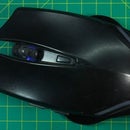Introduction: SMD - Hand Soldering
Instructables about hand soldering smd by soldering iron
With soldering iron, you can soldering almost smd packages like 0805, 0603, 0402, 0201, 01005, QFP, QFN, PLCC, SOT23, DPAK, ...
Step 1: Materials
- Soldering iron (can adjust temperature 200 ~ 450°C)
- Soldering tip (cut surface 45° or 60°)
- Soldering sponge
- Solder wick
- Tweezers
- Solder Wire (note: lead-free need higher temperature)
- Paste Flux (note: some type use only for lead-free solder)
For easy soldering, i recommend use lead solder (Sn/Pb: 60/40 or 63/37) for low temperature
Step 2: Clean Solder Pads
Clean solder pads for remove oxidized
You can clean with flux or tinning solder pads then remove by solder wick
Step 3: Alignment
Example with QFP100 package
- Put paste flux 2 points at opposite position
- Place chip, use finger or tweezers for alignment fit with solder pads
- Use finger or tweezers for press on top of chip
- Soldering 2 points for fixed chip
Step 4: Soldering
- Put paste flux for all pins on one edge of chip
- Setting temperature for soldering iron
Lead-free solder should 350~400°C, Lead solder should 315°C (±30°) (dependent on size of chip, pins, solder pads, trace width, heatsink ability of chip and pcb)
- Get enough solder on soldering tip
- Touch on first pin, drag to last pin as fast as possible (drag soldering)
or touch on first pin, jump to next pin and continue to last pin (pin to pin soldering)
Step 5: Touch Up
Sometimes the process is not as flawless as desired, like bridges, excess solder or cold solder joints. For solve, use flux and clean soldering tip. When touch up, excess solder will move to soldering tip, or you can use solder wick (not recommend)
Step 6: Clean Flux
For beauty solder joints, need clean flux even with no-clean flux
You can clean flux by alcohol like IPA (isopropyl alcohol) with wiper, cotton wiper, paint brush, toothbrush
Step 7: Videos
Step 8: Lead or Lead Free Solder ?
Video for compare 5 common alloys, maybe helpful for you choose solder type













